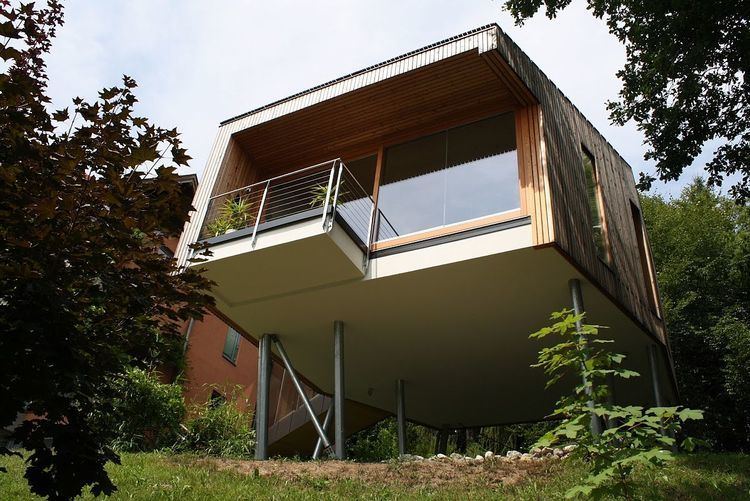 | ||
An Eco-house (or eco-home) is an environmentally low-impact home designed and built using materials and technology that reduces its carbon footprint and lowers its energy needs.
Contents
- Energy loss
- Insulation
- Passive solar gain
- Active solar gain
- Living gain
- Heat recovery ventilation
- Living heat loss
- Health
- Sustainable materials
- Timber
- Lime
- Reclaimed materials
- References
This includes:
The concept of an eco-house means a dwelling that has a low impact on the environment.
Energy loss
Buildings use up enormous amounts of energy. Some calculations make it as much as 70% of all the energy that we use in the UK when all the factors are taken into account. This energy is mainly for heating and lighting and therefore the aim is to design houses that are well insulated and make the best use of natural light.
Insulation
Increasing the amount of insulation is the main component of preventing energy loss. This includes draft exclusion, glazing, wall and roof insulation.
Passive solar gain
In the northern hemisphere, a south facing site will be a much better location than a north facing site because of access to sunlight and protection from the cold northerly wind. An eco-house starts life facing the sun.
Ideally the site for the house should have a south westerly aspect and be protected from the north and east. It’s not always possible to do this but there will usually be an opportunity to take advantage of the passive solar gain by having more glazing on either the front or the back of the building. Planting trees and creating wind breaks on the north and east sides of the site can enhanced the solar gain effect by protecting the house from the cold north easterly winds.
Having faced the house towards the sun, high performance windows are used to draw in as much light and warmth as possible. Sunlight then floods into the house and any heat generated is retained by a highly insulated building shell, draught proof windows and doors and thermal mass within the building.
Active solar gain
Orientation towards the sun also means that active solar systems can be fitted, both solar water heating panels and electricity generating solar panels on the roofs, further adding to the free heat and electricity gained from the sun.
Living gain
Living in the house also generates heat. Active human beings can produce as much heat as a one bar electric fire. Add to this heat from cooking, washing, lights etc. and you can begin to see how an eco-house could get too hot. Conventionally opening the windows reduces heat, but an eco-house design could include heat recovery ventilation systems.
Heat recovery ventilation
These systems extract the warm, moist air from bathrooms and kitchens and take the heat out of the stale, damp air before venting it outside. The heat recovery system transfers this collected heat to fresh air coming into the building and distributes it to the bedrooms and living rooms. Fresh air, at room temperature. An added benefit is that filters can be fitted on the air intake to provide a barrier to pollen or other irritants.
Living heat loss
With the passive and active solar gains, insulation, draft proofed building shell and heat recovery system, eco-houses could be zero heat, that is, in theory, you shouldn’t need to keep pumping heat into them from a central heating system. In practice life isn’t like that. Kids leave the door open, pets come in and out, people go out all day, cold snaps happen and some people like to sleep with the window open. An eco-house can incorporate design to have heating systems that can react quickly and efficiently to any changes in room temperature as well as providing a heat boost to the water temperature down-stream of the solar panels.
Health
Other benefits of an eco-house, aside from the obvious one of having minimal heating costs, are a healthy living environment. The heat recovery system can eliminate dampness and the moulds that are so often a health hazard. The air intake filters prevent dust coming in with the incoming fresh air and the internal vacuum cleaner system extracts dust from the house and vents it (via the dust collection bag and filter) to the outside, thus no microscopic particles of dust remain in the house.
Load bearing internal walls are minimised to allow rearrangements of the interior spaces, and the build technology is such that local trades can carry out alterations and easy maintenance.
For the health of the householder, and the planet, an eco-house should be built with materials that are free, wherever possible, from toxins or harmful products of the petro-chemical industry.
Sustainable materials
One of the wider issues of energy efficiency is the embodied energy within the construction materials. (Embodied energy is the energy taken up with producing and transporting the materials used).
Timber
Wood is a primary building material for eco-housing. This is because trees grow using energy from the sun, they don’t pollute, they produce oxygen, absorb CO2, they provide a wild life habitat, they can be replanted, they can be sourced locally, the timber can easily be put to some other use after a building is demolished.
Lime
Cement is a very useful building material and there are places where we have to be practical and use it. However, one alternative to cement is lime. Lime has been used as a building material for thousands of years and although energy and CO2 are used in its production it gently returns back to limestone in time, taking in CO2 in the process.
Reclaimed materials
There is also the use reclaimed materials, particularly bricks, slates and roof tiles, to make use of the embodied energy within these materials. This can also help new buildings to blend in with their surroundings.
